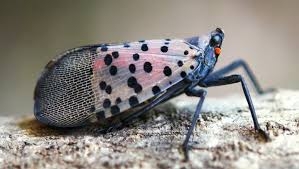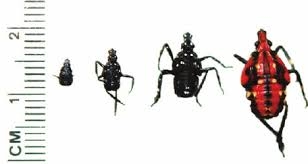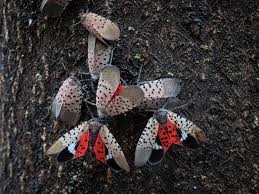Avocado growers have one more thing to worry about, just recently things have settled with the polyphagous shot hole borer and have recently had a wakeup call about the Redbay ambrosia beetle(Xyleborus glabratus)that carries the deadly fungus, Laurel wilt (Raffaelea lauricola). Now we have the invasive Spotted lantern fly (SLF)(Lycorma delicatula), to worry about. Originally from China, has spread to Korea and Japan, and has been found most recently in the United States in Pennsylvania in September 2014. The insect has now been found in New Jersey, Virginia and Delaware. These insects are pests of many agricultural crops including almonds, apples, blueberries, cherries, peaches, grapes and hops as well as hardwoods such as oak, walnut and our tasty avocados amongst other specialty crops. There is the potential for far reaching economic damage if the SLF becomes widely established in the United States and experts believe the lantern fly is likely to make its way to California soon. In 2019, California Department of Food and Agriculture (CDFA) inspectors have reported to date finding a total of 11 dead spotted lanternflies this year on cargo planes arriving at California airports in Sacramento, Stockton and Ontario when originally looking for Japanese beetles. The dead SLF specimens found on the cargo planes at California airports this summer and early fall were all adults. It is believed that they flew into the planes during loading activities at the airport in Allentown, PA and later died en route. The airport has since been treated to reduce and control SLF populations at the facility.
Biology
The name lanternfly can be misinforming; SLF have little in common with any type of fly. When looking at the adults with wings spread and can also make them look like moths. They are actually planthoppers in the order Hemiptera, or true bugs, and are closely related to brown marmorated stink bugs, aphids and leafhoppers. All insects in this order have piercing-sucking mouthparts which allow them to drill into the phloem of a plant to feed directly on the sweet sap and weaken the plant. From what is known in the current Pennsylvania infestations, SLF has shown to have one generation per year consisting of four nymphal stages, an adult stage, and overwintering as egg masses. Being true bugs, spotted lanternflies molt to progress between stages. Egg hatch is over an extended time period with the first instar nymphs appearing in May and June. Mating takes place starting in late August with egg-laying taking place in September through November or until the first killing freeze. It is unknown how exactly the life cycle would be in California, as the pests hasn't yet been found in California.
The first instar nymph is approximately ¼” long and black with white spots, and occasionally mistaken for a tick. Second and third instar nymphs are also black with white spots, but the fourth instar nymph takes on a red coloration with white spots and can be up to ¾”. Fourth instar nymphs molt and become adults approximately 1 inch in length. The adult SLF is about 2.5 cm (1 inch) in length. The fore wings are greyish-brown with black spots, with the wing tips having a darker, brick-and-mortar pattern. The hind wings are mainly red with black spots, followed by a white band and a black tip. When the spotted lanternfly is at rest, a hint of the red color can be observed through the forewings, but the color is especially noticeable when it is in flight. The body is mainly black, but the abdomen appears to be mostly yellow with black bands going down its length.
Signs and Symptoms
Spotted lanternfly causes damage to plants in two different ways. The nymphs and adults feed on plants using their piercing mouthparts to suck fluids from the stems or leaves. This has been shown to cause stunted growth, localized damage, reduced yields, and, in extreme cases, even death of the plant. Additionally, as the spotted lanternfly feeds, it excretes a sugary substance called honeydew. This honeydew, in addition to being attractive to ants, wasps, and other insects, is readily colonized by sooty mold, which can cause parts of the plants to become blackened, reducing photosynthesis and affecting the quality of the plants.
Source of threat
Spotted lanternflies have been documented to feed on over 70 species of trees and plants.Beware, the. SLF is a hitchhiker and are not shy.On their own, they are able to move 3 to 4 miles through walking, jumping and flying. However, can be spread long distances by people who move infested material or items containing egg masses. Egg masses, juveniles, and adults can be on trees and plants and are also found on bricks, stone, metal, and other smooth surfaces. SLF can also hitch a ride via vehicles, trailers, and even one's clothes.
What is currently being done
The CDFA recently granted Mark Hoddle from University of California, Riverside funds to test whether a tiny parasitic wasp, also originally from China, could be the solution to the forthcoming problem. The wasp has a needle-like appendage it uses to lay its own eggs inside the lantern fly's eggs. While developing, the wasp larvae eat and kill their hosts, and then emerge after chewing escape holes through the lantern fly eggs.
What you can do
Growers, you can inspect your trees and plants for signs of this pest, particularly at dusk and at night when the insects tend to gather in large groups on the trunks or stems of plants. Inspect trees (in particular, tree of heaven, an invasive tree itself) bricks, stone, and other smooth surfaces for egg masses which are usually very camouflaged. The female SLF covers her eggs with a creamy-white, putty-like substance that becomes pinkish-gray as it dries. After a few weeks the covering turns a darker tan and starts to crack, resembling a splotch of mud.Many photos of adult SLF show wings open, including the red underwings, but in nature this only occurs when the SLF is startled or is ready to take flight. It is much more common to see adults at rest with black-spotted, pinkish-tan wings folded over its back. Both male and female SLF have yellow abdomens with black stripes. Female SLF have a set of red valvifers at the distal end of the abdomen. When gravid (mated), the female abdomen swells to the point where they find it difficult to fly.
Work Cited
Barringer, L. E., Donovall, L. R., Spichiger, S. E., Lynch, D., & Henry, D. (2015). The first new world record of Lycorma delicatula (Insecta: Hemiptera: Fulgoridae). Entomological news, 125(1), 20-24.
Dara, S. K., Barringer, L., & Arthurs, S. P. (2015). Lycorma delicatula (Hemiptera: Fulgoridae): a new invasive pest in the United States. Journal of Integrated Pest Management, 6(1), 20.
Hoddle, M. (2019). Spotted Lanternfly is coming - California is getting ready, now!. California Pest Control Advisor Magazine, Aug. 2019. Vol. XXII (4),38-41.
Urban, J. M. (2019). Perspective: shedding light on spotted lanternfly impacts in the USA. Pest management science.


